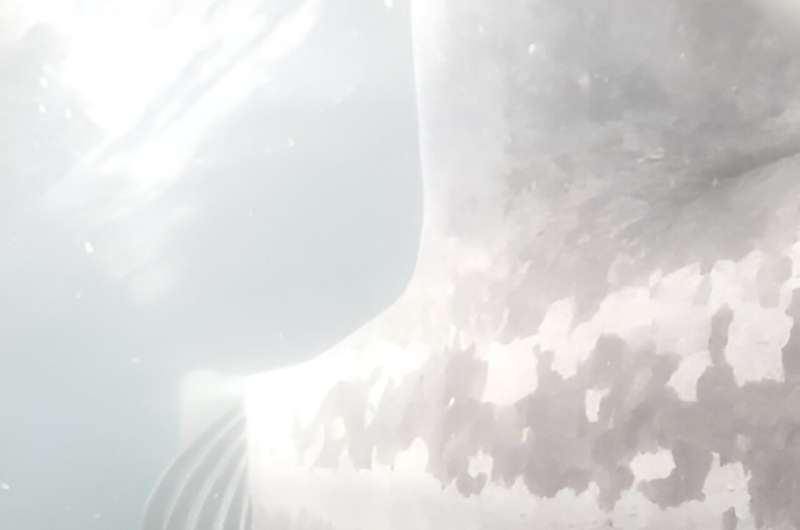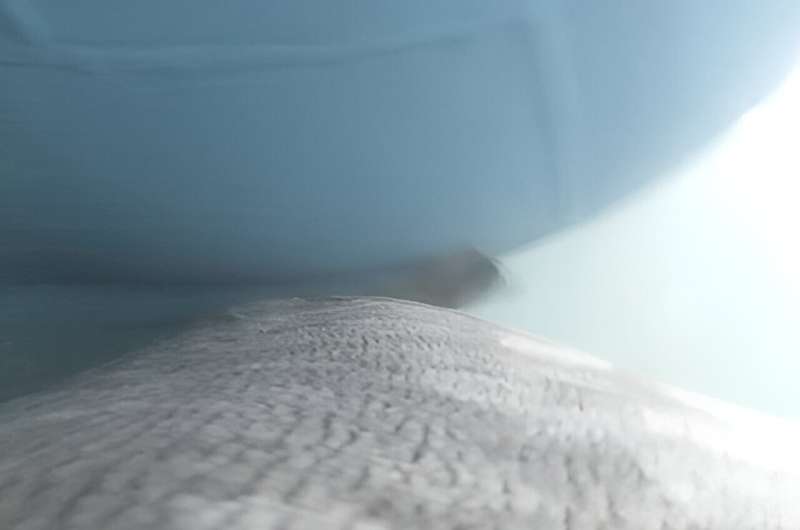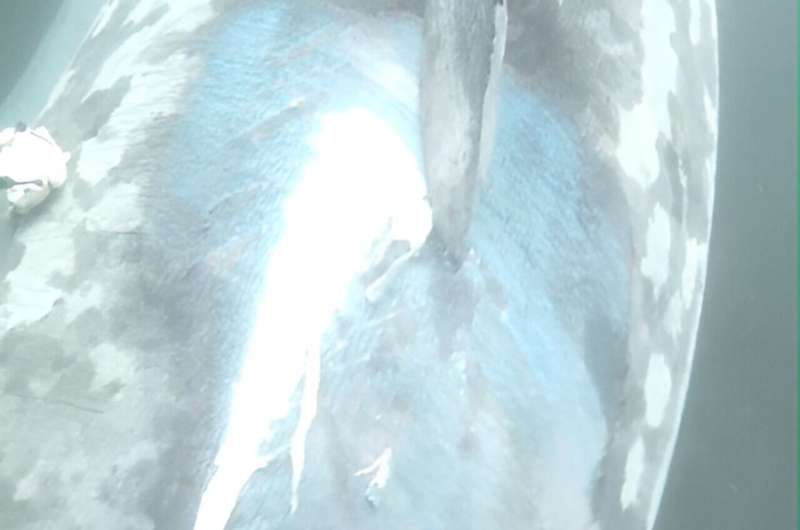This article has been reviewed according to Science X's editorial process and policies. Editors have highlighted the following attributes while ensuring the content's credibility:
fact-checked
peer-reviewed publication
trusted source
proofread
Researchers record first-ever images and data of a shark being struck by a boat

Hours after tagging an endangered basking shark off the coast of Ireland in April, researchers captured what they believe is the first ever video of a shark or any large marine animal being struck by a boat.
The data, collected by an activity measurement device similar to a FitBit and a connected camera, provided scientists a unique opportunity to learn more about the impact of vessel strikes on large marine animals, which is a rising concern around the globe, said Taylor Chapple, a shark researcher at Oregon State University's Hatfield Marine Science Center and lead author of the study.
"This is the first ever direct observation of a ship strike on any marine megafauna that we're aware of," Chapple said. "The shark was struck while feeding on the surface of the water and it immediately swam to the seafloor into deeper, offshore waters, a stark contrast to its behavior prior to the strike.
"Our findings demonstrate the risk and impact of vessel strikes and the need for measures to reduce this risk."
Researchers do not know whether the shark, a female about 7 meters long, eventually recovered from the strike. The tag was designed to release itself from the animal at a pre-determined time. About seven hours after the strike, the tag was released and later retrieved by researchers. The data showed that the shark never resumed feeding or other normal behavior while it was being monitored, Chapple said.
The findings appear in the journal Frontiers in Marine Science.

Basking sharks are the second largest known fish, frequently reaching more than 8 meters in length. They are listed as globally endangered by the International Union for Conservation of Nature, and Ireland is one of the only known locations worldwide where basking sharks continue to aggregate in large numbers.
They filter feed at the water's surface, similar to some whales, which makes them more susceptible to boat strikes. But unlike the whales, basking sharks often sink when killed, making it hard to gauge mortality rates, said Chapple, assistant professor in the Coastal Oregon Marine Experiment Station and Department of Fisheries, Wildlife, and Conservation Sciences in OSU's College of Agricultural Sciences.
Basking sharks in Ireland were protected under the country's Wildlife Act in 2022. Earlier this year, the Irish government announced the establishment of the nation's first National Marine Park, protecting 70,000 acres of land and sea on the coast of County Kerry where basking sharks migrate seasonally for feeding and potentially mating.
Shortly after the park's establishment, the researchers were conducting a previously planned study in the park boundaries to learn more about basking shark foraging behavior and how such behavior corresponds to environmental factors. As part of their research, they tagged the basking shark with a camera and activity monitor system while it was feeding.
After following the shark at a safe distance for a few hours, the researchers departed the area for the day. The tag was designed to record autonomously until its scheduled release, at which time the researchers located it and recovered the data.
Data from the tag revealed that for several hours following the tagging and tracking, the shark spent most of its time on the surface, continuing its normal feeding behavior, with an occasional dive. Then the shark attempted to make a quick, evasive movement, which was followed by the keel of a boat cutting across its back, just behind its dorsal fin. The shark tumbled through the water and immediately increased the frequency of its tailbeat as it headed to the seafloor.

Video from the camera showed visible damage to the shark's skin, paint marks and a red abrasion but no apparent bleeding or open wound. Vessel strikes are not always immediately lethal, but even non-lethal injuries can have short- and long-term consequences for the affected animal, the researchers noted.
"The fact that a shark we fitted our 'Fitbit' to was struck in this area within a few hours underlines just how vulnerable these animals are to boats and highlights the need for greater education in how to mitigate against such strikes," said co-author Nicholas Payne, an assistant professor at Trinity College Dublin's School of Natural Sciences. "Basking sharks filter feed at the surface, like some whales, and this behavior makes them similarly susceptible to strikes."
The incident highlights the need for additional research on the interactions between water users and basking sharks in the National Marine Park and other hotspots along the Irish coastline, said co-author Alexandra McInturf, a research associate in Chapple's Big Fish Lab at OSU and co-coordinator of the Irish Basking Shark Group.
"This research raises additional questions about whether and how often the sharks are actually occupying such habitats when they are not clearly visible at the surface," McInturf said. "Given that Ireland is one of the only locations globally where basking sharks are still observed persistently, addressing such questions will be critical to informing not only our ecological understanding of the basking shark, but also the conservation of this globally endangered species."
Additional co-authors are David Cade and Jeremy Goldbogen of the Hopkins Marine Station at Stanford University; and Nick Massett of the Irish Whale and Dolphin Group in County Kerry, Ireland.
More information: Behavioral response of megafauna to boat collision measured via animal-borne camera and IMU, Frontiers in Marine Science (2024). DOI: 10.3389/fmars.2024.1430961
Journal information: Frontiers in Marine Science
Provided by Oregon State University


















